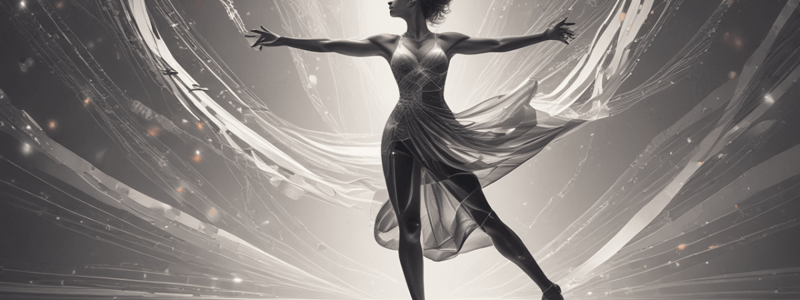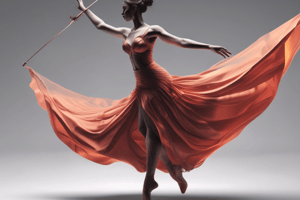Podcast
Questions and Answers
What is the primary purpose of experimentation in choreography?
What is the primary purpose of experimentation in choreography?
- To create predictable movement patterns.
- To push boundaries and challenge traditional norms in dance. (correct)
- To eliminate the use of props in dance.
- To follow traditional norms in dance.
What is one way to experiment with space in choreography?
What is one way to experiment with space in choreography?
- Experimenting with different arrangements of dancers on the stage. (correct)
- Focusing only on high levels in the performance space.
- Using only symmetrical formations.
- Eliminating the use of negative space.
What is an unconventional approach to rhythm in choreography?
What is an unconventional approach to rhythm in choreography?
- Using traditional rhythmic patterns.
- Eliminating the use of music in dance.
- Focusing only on slow movements.
- Breaking away from predictable and regular rhythms. (correct)
What is one way to utilize props in choreography?
What is one way to utilize props in choreography?
What is the result of movement exploration and experimentation in choreography?
What is the result of movement exploration and experimentation in choreography?
What is one spatial consideration in choreography?
What is one spatial consideration in choreography?
What is the purpose of exploring different levels in choreography?
What is the purpose of exploring different levels in choreography?
What is one way to experiment with pathways in choreography?
What is one way to experiment with pathways in choreography?
What is the purpose of considering spatial transitions in choreography?
What is the purpose of considering spatial transitions in choreography?
What is one way to experiment with groupings and formations in choreography?
What is one way to experiment with groupings and formations in choreography?
What is the primary purpose of integrating dynamics and motifs into a choreographic structure?
What is the primary purpose of integrating dynamics and motifs into a choreographic structure?
How do you refine and polish your choreography?
How do you refine and polish your choreography?
What is the outcome of incorporating dynamics and motifs into your choreography?
What is the outcome of incorporating dynamics and motifs into your choreography?
Why is it essential to evaluate and adjust your use of dynamics and motifs?
Why is it essential to evaluate and adjust your use of dynamics and motifs?
What is the importance of experimenting with different performance aspects?
What is the importance of experimenting with different performance aspects?
What is the outcome of continually evaluating and adjusting your choreography?
What is the outcome of continually evaluating and adjusting your choreography?
What is the primary goal of movement exploration in choreography?
What is the primary goal of movement exploration in choreography?
What is improvisation in the context of movement exploration?
What is improvisation in the context of movement exploration?
What is the purpose of task-based approaches in movement exploration?
What is the purpose of task-based approaches in movement exploration?
Why is integrating various dance techniques important in movement exploration?
Why is integrating various dance techniques important in movement exploration?
What is the result of movement exploration in choreography?
What is the result of movement exploration in choreography?
What is the role of movement exploration in choreography?
What is the role of movement exploration in choreography?
What is the benefit of using improvisation in movement exploration?
What is the benefit of using improvisation in movement exploration?
What is the outcome of using task-based approaches in movement exploration?
What is the outcome of using task-based approaches in movement exploration?
What is the purpose of incorporating rhythmic patterns into choreography?
What is the purpose of incorporating rhythmic patterns into choreography?
What is the effect of using syncopation in choreography?
What is the effect of using syncopation in choreography?
What is the role of tempo in choreography?
What is the role of tempo in choreography?
What is the primary purpose of dynamics in choreography?
What is the primary purpose of dynamics in choreography?
How can motifs be transformed and manipulated in choreography?
How can motifs be transformed and manipulated in choreography?
What is the purpose of incorporating accents and syncopation in choreography?
What is the purpose of incorporating accents and syncopation in choreography?
What is the result of incorporating spatial elements into choreography?
What is the result of incorporating spatial elements into choreography?
How can variation be added to motifs in choreography?
How can variation be added to motifs in choreography?
What is the purpose of incorporating motifs into choreography?
What is the purpose of incorporating motifs into choreography?
What is the result of experimenting with different rhythmic structures in choreography?
What is the result of experimenting with different rhythmic structures in choreography?
Flashcards are hidden until you start studying
Study Notes
Choreographic Tools and Techniques
- Movement exploration and experimentation are crucial in choreography, enabling creation of unique dance compositions
- Movement exploration involves investigating and expanding movement possibilities, allowing choreographers to develop a unique movement vocabulary
Techniques for Movement Exploration
- Improvisation: allows for organic and spontaneous movement creation, leading to unique and unexpected results
- Task-based approaches: provide specific instructions or constraints to guide movement creation, encouraging creativity and new ways of moving
- Technique integration: incorporates various dance techniques to enhance movement exploration and expand movement vocabulary
Experimentation in Choreography
- Experimentation allows choreographers to push boundaries, challenge traditional norms, and create innovative dance compositions
- Experimentation involves exploring new approaches, breaking away from conventional movement patterns, and discovering fresh perspectives
Tools for Movement Experimentation
- Manipulation of space: explores different arrangements of dancers on the stage, adding depth and dimension to the performance
- Alternative rhythms: experiments with unconventional rhythms, creating unexpected movement dynamics and adding an element of surprise
- Integration of props: incorporates props into choreography, altering movement qualities, creating obstacles, or enhancing the visual aspect
Spatial and Rhythmic Considerations in Choreography
- Levels and pathways: explores different levels and pathways, creating visual contrast and adding depth to choreography
- Groupings and formations: arranges dancers into different groupings and formations, creating visual harmony or tension
- Use of negative space: considers the space in between dancers, utilizing negative space to create tension, anticipation, or contrast
- Spatial transitions: pays attention to transitions between spatial positions, creating fluidity and continuity
- Dynamics of movement: considers how spatial elements interact with the dynamics of movement, enhancing movement qualities
Rhythmic Patterns
- Incorporates rhythmic patterns into choreography, adding complexity and musicality
- Experiments with different rhythmic structures, such as alternating rhythms, polyrhythms, or syncopation
- Uses accents and syncopation to highlight specific movements or accents within the rhythm
Using Dynamics and Motifs in Choreography
- Dynamics: refers to the varying qualities of movement, such as speed, intensity, and flow
- Motifs: are recurring movement patterns or themes, providing cohesion and unity to choreography
- Incorporating dynamics: selects music that inspires, identifies dynamic qualities, and creates movement phrases that embody these qualities
- Creating motifs: brainstorms and experiments with different movement ideas, refining and developing them into concise motifs
Developing Variation and Integration
- Develops variation by altering certain elements of the original movement, adding interest and depth to motifs
- Experiments with different ways to vary motifs, such as changing dynamics, levels, or timing
- Integrates dynamics and motifs into overall choreographic structure, refining and polishing through regular practice and feedback
Studying That Suits You
Use AI to generate personalized quizzes and flashcards to suit your learning preferences.




